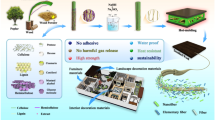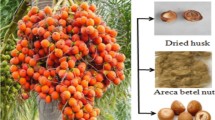Abstract
This paper presents the effect of varying wt% of randomly oriented bovine hair fibres on the microstructural, tensile and flexural properties of unsaturated polyester biocomposites. The fibres were characterized by scanning electron microscopy–energy dispersive X-ray Spectroscopy while the biocomposites were characterized by Biaxial Tensile Test, Three-Point Bending Test and Scanning Electron Microscopy. Empirical regression models were also developed for rapid prediction of selected tensile and flexural properties of the biocomposites. It was found that carbon is the principal element in bovine hair fibre and specific wt% of the fibre is suitable and efficient in delivering a biocomposite with optimum combination of the investigated properties. There also exist great correlations at 95% analysis of variance confidence level between experimental and predicted results. In comparison with the monolithic polymer, superlative enhancements of 1084.05, 595.39, 88.91 and 539.26% in tensile strength, tensile modulus, flexural strength and flexural modulus, respectively, were evinced by the biocomposites. The strains to fracture of the biocomposites were also comparable to that of the monolithic polymer; however, it decreases with increasing fibre wt% in the matrix. The developed materials are expected to find suitable applications as exterior prosthetics, dashboards/bumpers of cars, interior furniture of leisure boats, gratings and sanitary wares.






Similar content being viewed by others
References
Chen B, Cheng YS (2017) The impacts of environmental regulation on industrial activities: evidence from a quasi-natural experiment in Chinese prefectures. Sustainability 9:571. https://doi.org/10.3390/su9040571
Evelyn MI, Tyav TT (2012) Environmental pollution in Nigeria: the need for awareness creation for sustainable development. J Res For Wildl Environ 4:92–105
Mohanty AK, Misra M, Drzal LT (2002) Sustainable bio-composites from renewable resources: opportunities and challenges in the green materials world. J Polym Environ 10:19–26. https://doi.org/10.1023/A:1021013921916
Sharma S, Gupta A (2016) Sustainable management of keratin waste biomass: applications and future perspectives. Braz Arch Biol Technol. https://doi.org/10.1590/1678-4324-2016150684
Gupta A (2014) Human hair “waste” and its utilization: gaps and possibilities. J Waste Manag. https://doi.org/10.1155/2014/498018
Oladele IO, Olajide JL, Daramola OO, Siaw KB (2017) Re-evaluation of bovine fiber biomass as exploitable keratinous bio-resource for biomedical and industrial applications. JMMCE 5:1–17. https://doi.org/10.4236/jmmce.2017.51001
Gao L, Li R, Sui X, Li R, Chen C, Chen Q (2014) Conversion of chicken feather waste to N-doped carbon nanotubes for the catalytic reduction of 4-nitrophenol. Environ Sci Technol 48:10191–10197. https://doi.org/10.1021/es5021839
Barone J, Schmidt W, inventors; Barone Justin R, Schmidt Walter F, assignee (2005) Polymer composites containing keratin. United States patent application US 11/249,794
Olajide JL, Oladele IO, Agbabiaka OG, Akinwumi OO (2015) Tensile properties and fractographic analysis of low density polyethylene composites reinforced with chemically modified keratin-based biofibres. JMMCE 3:344–352. https://doi.org/10.4236/jmmce.2015.34037
Velasco MV, Dias TC, Freitas AZ, Júnior ND, Pinto CA, Kaneko TM, Baby AR (2009) Hair fiber characteristics and methods to evaluate hair physical and mechanical properties. Braz J Pharm Sci 45:153–162. https://doi.org/10.1590/S1984-82502009000100019
Yu Y, Yang W, Wang B, Meyers MA (2017) Structure and mechanical behaviour of human hair. Mater Sci Eng C 73:152–163. https://doi.org/10.1016/j.msec.2016.12.008
Nanda BP, Satapathy A (2017) Processing and characterization of epoxy composites reinforced with short human hair. In: IOP conference series: materials science and engineering, vol 178, p 012012. https://doi.org/10.1088/1757-899X/178/1/012012
Onuegbu TU, Azih AJ (2015) Effects of animal hair fibre on polyester resin. J Nat Sci Res 9:42–46
Agbeboh NI, Olajide JL, Oladele IO, Babarinsa SO (2018) Kinetics of moisture sorption and improved tribological performance of keratinous fiber-reinforced ortho-phthalic polyester biocomposites. J Nat Fibers 152:1–11. https://doi.org/10.1080/15440478.2018.1434849
Prochoń M, Przepiórkowska A (2013) Innovative application of biopolymer keratin as a filler of synthetic acrylonitrile-butadiene rubber NBR. J Chem 2013:1–8. https://doi.org/10.1155/2013/787269
Athijayamani A, Thiruchitrambalam M, Manikandan V, Pazhanivel B (2010) Mechanical properties of natural fibers reinforced polyester hybrid composite. IJPT 14:104–116. https://doi.org/10.1007/s12588-009-0016-0
ASTM D638–14 (2014) Standard test method for tensile properties of plastics. ASTM International, West Conshohocken
ASTM D790-15e2 (2015) Standard test methods for flexural properties of unreinforced and reinforced plastics and electrical insulating materials. ASTM International, West Conshohocken
Origin Help Online (2018) Interpret regression result. http://www.originlab.com/doc/Origin-Help/Interpret-Regression-Result. Accessed 08 March 2018
El Grushka B, Flieger J, Huber M, Kocjan R (2014) Examination of the elemental composition of hair in cholelithiasis, kidney stone, hypertension and diabetes by scanning electron microscopy and energy dispersive spectrometry SEM/EDS. J Anal Bioanal Tech 5:207. https://doi.org/10.4172/2155-9872.1000207
Chae HG, Newcomb BA, Gulgunje PV, Liu Y, Gupta KK, Kamath MG, Lyons KM, Ghoshal S, Pramanik C, Giannuzzi L, Şahin K (2015) High strength and high modulus of carbon fibres. Carbon 93:81–87. https://doi.org/10.1016/j.carbon.2015.05.016
Srivastava P, Sinha S (2016) Effect of alkali treatment on hair fiber as reinforcement of HDPE composites: mechanical properties and water absorption behavior. Sci Eng Compos Mater. https://doi.org/10.1515/secm-2016-0198
Author information
Authors and Affiliations
Corresponding author
Additional information
Publisher's Note
Springer Nature remains neutral with regard to jurisdictional claims in published maps and institutional affiliations.
Electronic supplementary material
Below is the link to the electronic supplementary material.
Rights and permissions
About this article
Cite this article
Olajide, J.L., Oladele, I.O., Agbeboh, N.I. et al. Improved strength, modulus and tolerable ductility of ortho-phthalic polyester biocomposites reinforced with keratinous bio-resource. Int J Plast Technol 23, 67–76 (2019). https://doi.org/10.1007/s12588-019-09227-6
Received:
Accepted:
Published:
Issue Date:
DOI: https://doi.org/10.1007/s12588-019-09227-6




